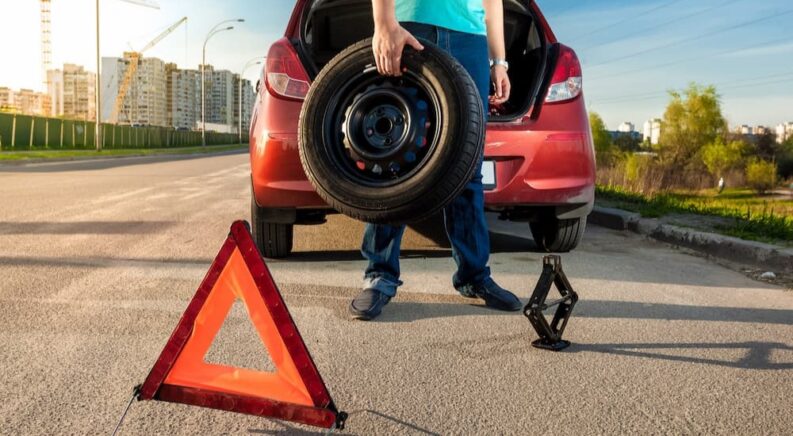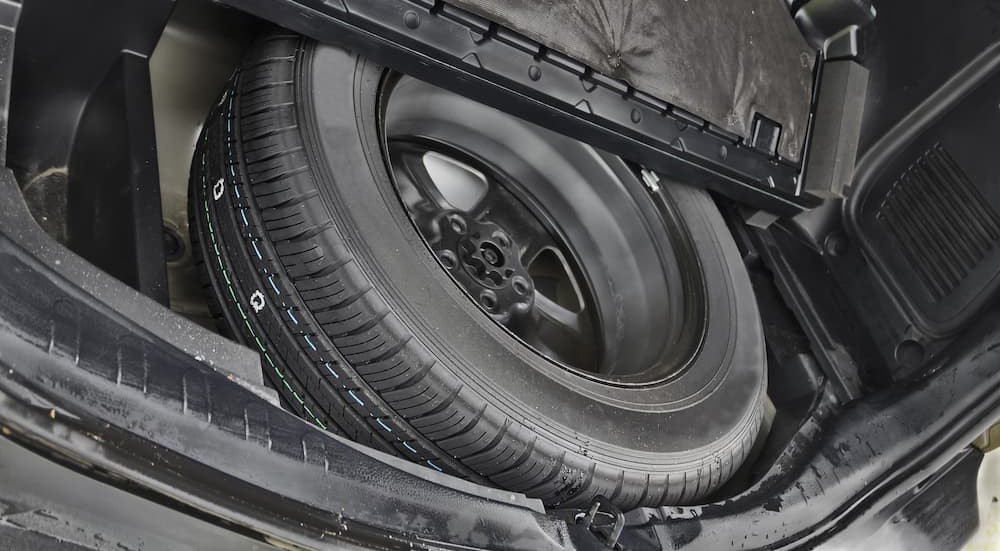It’s practically inevitable you’ll eventually find yourself with a flat tire. Multiple sources report that roughly 220 million flat tires occur in the US every year—and on average, a driver will experience five flat tires in their lifetime. Although roadside assistance and towing services can get your car to safety, this will take a lot of time. Furthermore, if these services aren’t included in your insurance plan, costs can add up quickly.
As such, it’s important to have an emergency repair solution that can get you going faster. The two main options when dealing with flats are spare tires and inflation kits. Which one is better to have handy—or is it better to have both? As someone who has dealt with deflated tires multiple times, I decided to look at the spare tire vs tire inflator kit debate and offer some insight so you’re prepared if a tire suddenly goes down.
Pros and Cons of Spare Tires
The spare is the classic way to deal with a flat tire—put another one on and keep going. However, while spare tires were once an almost universal feature, they have become less common in recent years. According to Consumer Reports, only about 60% of vehicles they have tested since 2020 came with a spare tire—and only 10% had full-size spares. (The rest had temporary space-saver tires, also called compact or “donut” spares.) This shift is because automakers are trying to 1) lower manufacturing costs, 2) meet federal fuel economy requirements by reducing weight, and 3) save space for other equipment.
The good news is that if your car doesn’t come with a spare tire, you can probably add one. Most vehicles still have a compartment at the base of the trunk large enough for a compact spare and related tools. On some hatchbacks and SUVs, you can install an exterior spare tire mount. Per Consumer Reports, a full space-saver spare tire kit, including the lugs, wrench, and jack, starts at around $150. Here’s the breakdown of a spare tire’s advantages and drawbacks.
Spare Tire Pros:
- Spare tires let you address any type of tire damage, from embedded screws to sidewall rips. You don’t need to worry about doing more damage to the tire or messing up the repair process.
- Putting a spare tire on allows you to drive more normally until you can get the damaged tire repaired or replaced. Although space-savers have some limits on distance and top speed, they won’t come into play in most conditions.
- If the tire has been properly cared for, it is statistically unlikely to puncture again before you get a replacement tire. This means you can use the same spare tire multiple times, saving you money in the long term.
- A full-size spare can be part of your regular tire rotation, helping the other tires last longer.
Spare Tire Cons:
- For donut spares, you must be careful to observe driving limits on highways and long trips. Exceeding these limits will likely damage the tire and can also affect parts of the powertrain. The rule of thumb is not to go over 50 mph while driving on a donut spare.
- You need to periodically check the spare to make sure it’s properly inflated and in good condition. Otherwise, it won’t do you any good when you need it. You’ll also have to check the condition of the lug nuts, lug wrench, and jack.
- Changing a tire can be challenging and even unsafe for people who aren’t mechanically inclined. You’ll need to know how to use a jack—and some people simply aren’t strong enough to loosen lug nuts, especially if they get stuck to the wheel. According to AAA, 18% of drivers admit they simply don’t know how to change a tire.
- Finally, a spare tire kit takes up trunk space and adds vehicle weight. This affects luggage capacity, fuel mileage, and overall driving performance. If the spare is exterior-mounted, it can be damaged by weather or impacts.
Pros and Cons of Tire Inflation Kits
Most vehicles that don’t include a spare tire are equipped with tire inflator kits or patch kits. You can also buy them at any auto parts store. The standard kit includes an air compressor to inflate the tire, a sealant or foam you spray into the tire to fix minor punctures, and a gauge to view the tire pressure. Some tire inflation kits also work using an aerosol spray can. A kit’s cost can range from $10 to $80, depending on its function and quality.
Tire Inflation Kit Pros:
These kits take up much less space than a spare tire, leaving more cargo area for storage and gear.
Tire inflator kits work faster and are easier to use than tire-changing equipment. You don’t need to worry about finding a jacking point or being strong enough to remove the lug nuts.
Once the sealant has taken effect, you can drive longer and faster than on a donut spare.
Tire Inflation Kit Cons:
- An inflation kit doesn’t always stop an existing leak. This is especially true if you have an object embedded in the tread (such as a nail), there is a major puncture, or if the sidewall is damaged.
- After using a sealant, you must drive very slowly for the first few miles (typically no more than 20 mph) to let the sealant spread. This can be hazardous on highways and in high-traffic areas.
- To do a permanent tire repair, the sealant must be removed, and you’ll also need to replace the pressure monitoring sensor (coating the sensor with sealant renders it inoperable). This can make tire repairs cost up to 10 times more than if you use a spare tire.
- Inflation kits have a limited amount of sealant—often only enough for one use. At that point, you’ll have to refill the sealant or buy a new kit.
Should You Get Both?
Having a spare tire and an inflation kit gives you the best of both worlds. You can use the tire inflator kit for minor tire damage to get you back on the road fast and the spare if there’s moderate or severe damage. The biggest challenge to this is finding enough space to carry each system. You’ll also need to account for both in your operating budget.
How to Reduce My Chances of a Flat Tire
As I said earlier, it is nearly certain you will get a flat tire at some point. However, there are some things you can do to minimize the risk. Many of these tips also optimize traction, handling, and fuel mileage.
- Use high-quality tires that are professionally mounted and installed.
- Make sure your tires are properly inflated. Too much or too little air pressure both increase your risk of a flat.
- Replace the tires once they’ve reached the recommended mileage limit(. Worn-out tires are weaker and more likely to puncture.
- Regularly get the alignment and balance checked to prevent uneven wear and grooves.
- Regularly rotate your tires since the front and rear tires wear at different rates.
- Try to avoid roads with potholes, bumps, sharp rocks, debris, and other hazards that can damage tires.
- Don’t load the car with more weight than the tires are designed to handle.
Be Ready for Tire Disasters
Even if you diligently look after your tires and drive carefully, a flat tire can happen due to something out of your control. Having an emergency spare tire, inflation kit, or both means less worry. Use this guide to decide which you should keep in your vehicle to get driving again.



